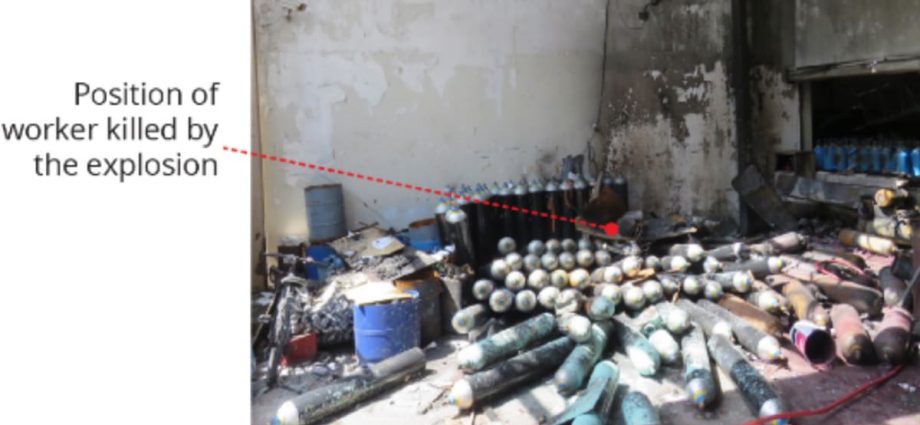
SINGAPORE: A foreign worker who died in a gas explosion while checking gas cylinders at a building in Tuas had suffered 95 per cent burns to his body, with a coroner’s inquiry on Monday (Sep 2) revealing the poor workplace safety practices in place.
Mr Manku Suri Appa Rao died aged 38 on Dec 30, 2022 after the explosion, which was fuelled by acetylene – a highly flammable, colourless gas – left in cylinders he was checking.
The Indian national was the 46th workplace fatality that year.
The inquiry into his death opened on Monday before State Coroner Adam Nakhoda, with a representative from the Ministry of Manpower (MOM) stating that the ministry is considering taking action against those involved.
The court heard that the fire was determined to be accidental in nature, likely originating from acetylene cylinders that Mr Rao was checking and maintaining with another colleague.
The cylinders were supposed to be spent, but contained remnant gas which likely acted as fuel for the explosion. Acetylene is highly flammable, with a concentration of as low as 2.3 per cent in the air able to result in combustion.
A fire investigator told the court that the most probable cause of the fire was an electrical source, such as from electric sockets, wirings or components.
Although the two employees were working in a relatively open area, the area was likely not well-ventilated, said the investigator.
This was because a witness stated that he had to turn on two fans to blow away dust from his work.
According to MOM’s representative, the valve stems of 19 cylinders were found to be loosened. This could have resulted in a release of remnant gas into the area.
The fire raged for about 23 minutes before the Singapore Civil Defence Force extinguished it.
The ventilation by the two fans could have been inadequate for the 19 cylinders, said the representative.
POOR WORKPLACE SAFETY PRACTICES
The court heard that there was no consideration at the workplace for the effective capture and removal of gas, beyond the use of the fans for “dilution and ventilation”.
There were also no gas detectors for flammable gas, and investigations revealed that there was a difference between what was put down as safe work procedures to be followed and actual operations.
Operators were allowed to improvise their manner of work according to their preference.
Production operators were responsible for identifying gas cylinders requiring maintenance and to vent them by gradually opening the valves to ensure no gas remained inside. This was to be done by verification with a pressure gauge.
The venting process was supposed to be repeated until the pressure gauge displayed zero.
However, interviews later revealed variations in processes. There were no standardised venting work processes or a single pre-determined venting location.
Workers were told there were a few locations within the premises they could vent the cylinders at, and it was left to them to make the choice.
There was also no mention of staggering the work done, such as to fully vent each of the 19 cylinders before moving on to the next.
Some operators also used their hands to test the gas pressure and used the pressure gauge only if they felt the pressure was high.
The workplace also did not undergo a proper identification and classification of hazardous areas, such that adequate measures could be taken, the MOM representative said.
There was also no designated person responsible for checking electrical equipment prior to the accident.
After the incident occurred, a workplace safety and health bulletin was issued in January 2023, calling on companies storing or handling flammable gas cylinders to urgently assess their safety measures.
Suggested measures include:
- Discharging flammable gases from cylinders only under safe conditions and after a thorough assessment of work and environmental risks
- Flammable gases should be discharged through vent lines to a safe location, with control valves and a flame arrestor well as effective ventilation to prevent flammable gas build-up
- Removing all potential sources of ignition and checking electrical outlets for overloading
- Equipping workers with personal protective equipment
The coroner will release his findings at a later date.

